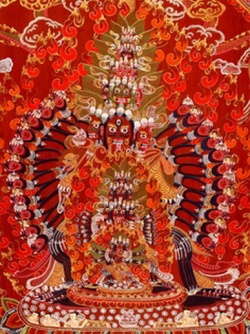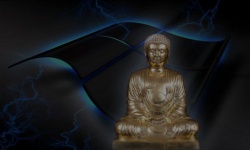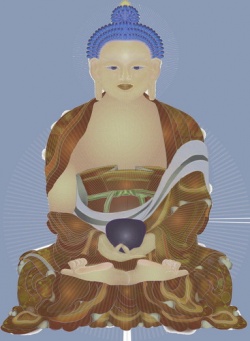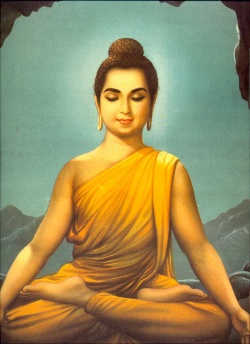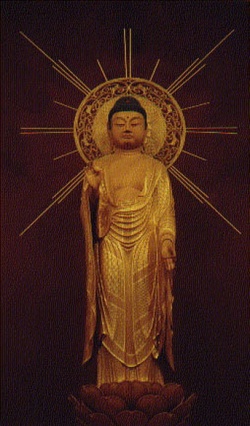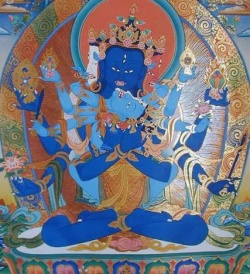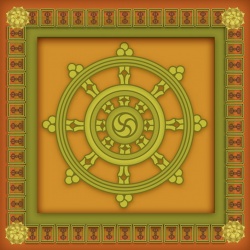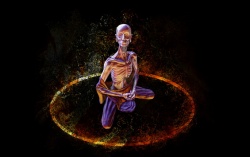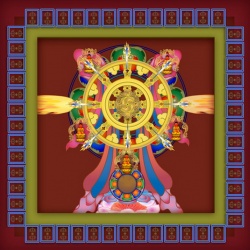The development of the Perfection of Wisdom literature
According to tradition, the Perfection of Wisdom literature springs from Sakyamuni Buddha, but he found that the teachings were not appropri- ate for the men and women of his time, and shortly before his parinirvana, or passing away, he entrusted the teachings to the nagas. Nagas in Buddhist tradition have something of the same characteristics as dragons. They are long-lived, wise, and can function as guardians of treasures. Nagas live at the bottom of the ocean, and it was in their watery kingdom that the Wisdom teachings were preserved. Several centuries later one of the greatest figures in Buddhist history, Nagarjuna, came to the edge of a certain lake and received the Perfect Wisdom teachings from a naga princess.
The first Perfection of Wisdom teachings appeared about 100 BCE. During a two hundred year phase of development the basic texts of the literature appeared. The oldest are probably the Astasahasrika, or Perfection of Wisdom in 8,000 Lines, and its verse counterpart, the Ratnagunasamcayagatha (verses on the storehouse of precious virtues). In the following 200 years the Perfection of Wisdom literature achieved great popularity. So much devotion was lavished upon it that it expanded. One text even reached 100,000 lines in length. The succeeding 200 years (roughly 300-500 CE) saw the Perfection of Wisdom spread throughout India and into China.
In this phase the new texts became increasingly concise. Among them are two of the most famous and important of all Buddhist works: the Diamond Sutra (Sanskrit Vajracchedika) and the Heart Sutra (Sanskrit Hrdaya)." By the year 700, the process of contraction had gone as far as possible. There is a 'Perfection of Wisdom in a Few Words' which says it is for the 'dull and stupid'. There is even the 'Perfection of Wisdom in a Single Letter'! This is the letter A, which in Sanskrit is a negative prefix. It is as though the text says that whatever you think, however you try to describe the world, you should put the word 'not' before it. However you explain the universe, Reality is not that.
The Perfection of Wisdom denies that you will ever catch Reality in the clumsy net of words and concepts, and breaks up your preconceptions about everything. You say you are of a certain age, sex, nationality, occupation, and so on. The 'Perfection of Wisdom in One Letter' denies that in Reality you are any of these things. They are just the fool's gold of conventional descriptions, not the true gold of Reality. Also during this period, something very remarkable happened. The Perfection of Wisdom, under the influence of the Tantra, began to change. This literature of uncompromising paradox and intellectual subtlety transformed itself.
From being an intellectual thunderbolt, destroying conceptualizations, it was reborn as a wisdom goddess and a mantra. Examining this extraordinary 'sea change' can give us insights into the Tantric approach to self-transformation. Tantra, we have seen, is always concerned with direct experience. Rather than denying words and concepts in the hope that you will reach beyond them, it employs a different approach. It tries to help you leave behind conceptualization by entering an imaginative realm. You enter a realm of light, travel in a realm of gold. In this archetypal realm you are brought face to face with Wisdom, in the most appealing form imaginable.
At about the time of Charlemagne, the figure of Prajnaparamita (Tibetan Sherapkyi Pharoltuchinma) as a Wisdom goddess began to appear in the East. She had different forms: sometimes golden, sometimes white. She appeared with two, four, or six arms, or even (in a form popular in Cambodia) with eleven heads and eleven pairs of arms. She appeared, over time, in Japan, Java, Cambodia, China, and Tibet. However, the Tibetans had already fallen in love with Tara, so her cult never gained great popularity there. It was in India, above all, that the goddess Prajnaparamita manifested. There was even a great statue of her on the Vulture's Peak at Rajgir, where the Buddha gave so many discourses. India being the centre of devotion to Prajnaparamita, when the Muslims trampled Buddhism underfoot in that country, her cult largely disappeared.
As the Muslims systematically destroyed the monasteries, smashed statues, and burned books, the Wisdom goddess went into hiding. It is really only in the twentieth century, and due largely to the work of one man, that the goddess is once again displaying her face in so many different lands. The life's work of the German scholar Edward Conze was to translate virtually all the Perfection of Wisdom texts into English. Thanks to his efforts the goddess moves freely among us once more. Though the cult of Prajhaparamita survived and continued outside India, so weakened had it become that after extensive research Edward Conze could catalogue fewer than fifty icons of her in existence. Since then, at least one more has come to light. A few years ago a film crew went to Tholing in western Tibet to record the extraordinary temple paintings there.
They had been neglected, and some were so covered in dust as to be unrecognizable. The crew filmed the dust being carefully removed from an anonymous mural. As the picture was cleaned in front of it, the camera recorded the apparition of an exquisite golden goddess. Emblems of the Wisdom goddess In her different manifestations, Prajnaparamita is shown with various symbols or emblems. There are six main ones, and we shall perhaps come to understand our Wisdom goddess better if we look briefly at each of them in turn. (I) The lotus. The lotus is a symbol for that which transcends the mundane. So, although we have been speaking of her as a goddess and of meeting her in the archetypal realm, it is clear that Prajnaparamita is essentially a manifestation of the dharmakaya. The lotus is also a symbol of spiritual receptivity.
To 'understand' the Perfection of Wisdom we have to be prepared to stand under it, and learn from it. In doing so we may even have to accept that we do not know anything about anything, spiritual or mundane! This is, in a sense, the message of the Heart Sutra - that our experience is ungraspable, and even the concepts of Buddhism do not capture the truth of things. At best they are only 'fingers pointing to the moon'. (2) The book. Her association with the book emphasizes that Prajnaparamita embodies the wisdom of all the books in the Perfect Wisdom corpus. The book also represents the fact that, although we aspire to go beyond words and concepts, most of us cannot just ignore culture and learning. We need to train and develop our rational faculty, not try to dispense with it. Once we have fully trained our intellect, then we can turn it to the Perfection of Wisdom, and let it discover for itself its inadequacy in apprehending Reality. The rational mind has to be developed to a point where it can see through itself- acknowledge its own limitations.
The vajra. It may seem strange for a gentle goddess to wield such a weapon - though Athena, another wisdom goddess, is also a warrior. Transcendental wisdom is both soft and hard. It is soft in the sense that it is subtle and elusive. If you try to grasp it directly you will always fail. It comes to you gently, from the side, as it were - from a 'direction' you cannot cover. Because of that it is hard in the sense that it cannot be parried. It smashes to pieces all our mundane ideas about reality. Thus Perfect Wisdom has a destructive aspect, which the diamond thunderbolt well symbolizes. (4) The sword. The flaming sword is an attribute of Manjusri - the Prince of Wisdom. Manjusri and Prajnaparamita represent two methods of approach to the goal of wisdom, so it is not surprising that they should share certain symbols.
The mala. A mala (Tibetan trhengwa - literally 'garland') is what in the West would be called a rosary. In Buddhism it is used for counting mantras and other practices. Its association with Prajnaparamita suggests the importance of repetition for arriving at wisdom. In the West especially, where novelty is the great goddess, we tend to flit from one experience to another. All too often having done, or read, something once, or at most a few times, we feel we have drunk the experience to the dregs. Novelty lives on the surface of life, but Perfect Wisdom is preserved in the depths. To achieve wisdom through the Perfection of Wisdom texts we have to read them repeatedly (some of the sutras reiterate themselves - eightyper- cent of the Perfection of Wisdom in 100,000 Lines consists of repetitions.) We need to meditate repeatedly on the same themes of emptiness and impermanence. It is only with this devoted, loving return to the same sources of inspiration that we shall gradually deepen our insight, shall come to understand the same sutras and subjects in ever-deepening ways. Prajnaparamita does not reveal all her secrets at a first meeting. To woo her successfully we have to be faithful to her.
The begging-bowl. This is the utensil of the wanderering Buddhist monk or nun. It symbolizes the movement away from worldly ties. It implies the need for renunciation if we are to find Perfect Wisdom. We may not physically leave our home and our country, but in the search for Wisdom we shall have to be prepared to give up our old cramped self and our conventional ideas about the world. The visualization of Prajnaparamita We have seen that Prajnaparamita appears in a number of forms, and can have various symbolic attributes. Naturally, then, there are various traditional ways of visualizing her. Geshe Kelsang Gyatso describes a practice in which she is visualized in connection with recitation of the Heart Sutra. ~ This practice was used in Tibet for warding off hindrances - especially the four Maras.
These are personifications of all the negative forces - internal and external - that hinder our quest for Enlightenment. The Sadhanamala, a very important Indian collection of visualization practices, gives nine different sadhanas of Prajnaparamita. Rather than examining a sadhana in detail, we shall look at part of one of these visualizations. It begins with a series of magical transformations that take place within the blue sky of Emptiness. First, on a lotus and moon in front of us, appears the syllable dhih. This is the seed syllable particularly associated with transcendental wisdom. We have already met it in the mantra of Manjusri. The seed syllable shines in the blueness, made of golden-yellow light. Next we see a book of the Perfection of Wisdom. It is usually visualized not as a bound volume but in the form that one finds in Tibetan monasteries.
The leaves of the manuscript are sandwiched loose between covers - like a thick book with no spine. They are then wrapped in silk. Perhaps in the future, Western meditators will see it as an ancient, leather-bound volume. Then on a full-blown lotus appears Prajnaparamita herself. So the sequence of the visualization is first the seed syllable, then the book, and finally the goddess. It is as though the practice recapitulates the whole development of Perfect Wisdom in human consciousness. First there is just the blue sky, the experience of Emptiness itself. Then the seed appears - a communication of Wisdom on the most subtle of levels. Next the teaching is put into words, into the Perfection of Wisdom literature. Finally it appears again, transfigured into a golden goddess.
This goddess is seated on a blue lotus and a white moon mat. She is not sixteen years old like the Bodhisattvas; she is much more mature than that, though still very beautiful. Wisdom is something that takes time to ripen. Prajnaparamita is often described as 'the mother of all the Buddhas'. She is mature in having given birth to countless Buddhas. Prajnaparamita represents the realization of Sunyata, and there is no other way to gain Enlightenment. As the Heart Sutra has it, A Bodhisattva, through having relied on the perfection of wisdom, dwells without thought-coverings. In the absence of thought-coverings he has not been made to tremble, he has overcome what can upset, and in the end he attains to nirvana.
It is Perfect Wisdom which gives birth to Buddhahood. Prajnaparamita is said to regard the Buddhas like a mother fondly watching her children at play. She wears a tiara with jewels of the five colours. These embody the wisdoms of the five Buddhas. Her hands are placed in the mudra of teaching the Dharma. She holds the stems of two lotuses, which open out into pale-blue blossoms, one at each shoulder.'4 As always, upon each of them is a white moon mat. On each moon mat lies a book of the Perfection of Wisdom. There is just one more very striking feature of the goddess. We have said that she is golden yellow in colour. However, if we look closely we shall see that the golden-yellow light from her body is given off by millions of Buddhas. Her whole body is made up of golden Buddhas. It is as though the goddess of the Perfection of Wisdom is a great galaxy.
Seen from afar, the galaxy is in the most pleasing shape imaginable. Coming closer, we see that it comprises endless Enlightened Beings: constellations of Buddhas, starry multitudes of Awakened Ones. Then light emanates from the centre of the galaxy, from the heart of Prajnaparamita. Down the light ray comes the mantra of the Wisdom goddess:
om ah dhih hum svaha.
It enters your heart and begins to echo there, bestowing wisdom on you through another of its transformations.
The mantra
om ah dhih hum svaha
which is used in this sadhana conveys the message of the Prajnaparamita literature, but through the medium of symbolic sound. It is one of three mantras commonly associated with the Perfection of Wisdom. It is not readily translatable, appealing only to a level of the psyche that does not trade in words.
The other two common mantras can be given some rational explanation.
First there is the mantra
gate gate paragate parasamgate bodhi svaha."
This comes at the end of the Heart Sutra, and is more generally associated with the Perfection of Wisdom literature than with the Wisdom goddess, though it does appear in some of her sadhanas. It has been translated by Edward Conze as 'Gone, gone, gone beyond, gone altogether beyond, O what an awakening, all hail!' The mantra symbolizes a deepening apprehension of Reality. According to one tradition, its first four words correspond to the four levels of Sunyata. The first gate (pronounced gutt-ay) symbolizes going beyond samsara.
The second represents the emptiness of the concept of nirvana, especially the view of Enlightenment as something distinct or separate from the phenomenal world. With paragate one realizes the emptiness of all distinctions, and in particular that between samsara and nirvana. With parasamgate one goes beyond all concepts whatsoever, even letting drop the idea of Sunyata. Gelukpa lamas relate these four words to the first four of the Mahayana paths, and bodhi or bodhi svaha to the fifth.
Secondly there is the homage found at the beginning of the Heart Sutra, which can be repeated as a mantra:
om namo bhagavatyai aryaprajhaparamitayai.
Edward Conze translates this as 'Homage to the Perfection of Wisdom, the Lovely, the Holy'. The gate gate mantra, with its association with the four levels of Sunyata, might appeal to those more intellectually inclined, whereas this invocation is an outpouring of faith and devotion to the goddess. It is characteristic of Buddhism that it should provide such differing paths to the goal. Regularly performing a sadhana of Prajnaparamita produces an ever deepening involvement with the Wisdom goddess. To start with, the goddess becomes a focus for devotion. For men, her practice can often absorb the romantic and other feelings that might be evoked by meeting a beautiful, mature woman.
For women, she is often a figure with which to identify, the most positive of all role models. Thus for both sexes energy can easily be engaged by the meditation, and hence poured into the contemplation of Wisdom. If this process continues, the practice enters the realm of the archetypal. In Jungian terms, a man may project the highest aspect of his anima, while a woman may encounter the Magna Mater. She becomes for the meditator the archetypal Wisdom goddess found in many traditions. For the Gnostics she was Sophia, for the Greeks Athena. She is found in the Tarot as the High Priestess, who holds a scroll - corresponding to the book of Prajnaparamita.
She is seated between two pillars - one light, one dark. Imbibing her knowledge will enable you to pass between the pillars and transcend all dichotomies. Prajnaparamita is the Wisdom goddess of India - once described as staggeringly beautiful to the point of being scorching. Her meditation can become a way of experiencing the archetypal beauty of the refined levels of one's mind. Finally, with faithful practice, she can become far more than that. She can become the experience of transcendental wisdom itself- the transcendence of the world of subject and object. Anyone who reaches this level will truly begin travelling in realms of gold. They will be carried up to a fresh vantage point, a new peak of their being. From that pinnacle they will see not a new ocean or a new planet, but a new reality.
They will be reborn out of the infinite creativity of the Wisdom goddess, and will add their brilliance to the galaxy of golden Buddhas. Vajrasattva - Prince of Purity In meeting Vajrasattva (Tibetan Dorje Sempa) in this chapter, we are encountering for the first time a Buddha who does not appear in the Mahayana sutras, only in the tantras. He is a rather mysterious, even esoteric, figure, who plays a number of important roles in Tantric practice. Sometimes he appears as a kind of reflex of the deep blue, immutable Buddha, Aksobhya. At other times he appears as the 'adi-Buddha' - pure white, naked and unadorned, in sexual embrace with a white female partner. Adi means from the beginning or primordial. This does not mean he has existed since the beginning of creation - Buddhism does not think in those terms.
The adi-Buddha does not appear at a first point in time, he transcends time altogether. He represents the potential of the mind to transcend the continuum of time and space, a potential that is always available to us. When you emerge beyond these limitations of consciousness, you find you are Enlightened. Not only that; beyond time, you find you have always been Enlightened. In your essential nature you have always been a 'diamond being', have always been Vajrasattva. This diamond nature, outside time, is totally pure. It has never been sullied or stained by any of your actions within time. Hence Vajrasattva represents the beginning less purity of your deepest nature.
The path to Enlightenment of the devotee of Vajrasattva, then, is a path of ever-increasing purification. One of the most important sets of meditation practices in the Tantra, used in slightly varying forms by all schools of Tibetan Buddhism, is known as the mulct, or Foundation, Yogas. These are often performed as preliminaries to the practice of Highest Tantra (anuttarayoga), and are in themselves extremely effective methods of self-transformation. The first, according to a common Nyingma classification, is Going for Refuge and Prostrations. This involves visualizing a vast assembly of Buddhas, Bodhisattvas, and other symbols of the transcendental path, and reciting a formula committing yourself to attain Enlightenment. At the same time you make full-length prostrations on the ground, and imagine all living beings reciting and prostrating with you.
This recitation and prostration is repeated 100,000 times over a period of months or years. Performed wholeheartedly, this practice greatly deepens your commitment to following the Buddhist path to its endless end. The aim of the second practice is the development of the Bodhicitta, the cosmic will to Enlightenment. Again, there is a verse to be recited 100,000 times. By the time this is completed, you know that you can never be satisfied with making your own escape from the prison of samsara. You are now committed to engineering a 'mass breakout' - to helping all living beings to attain Enlightenment. Out of the first two mula yogas comes the determination to gain Enlightenment as fast as possible, so as to help all living creatures who have been circling in samsara since beginningless time.
But, according to Buddhist tradition, you too have been taking rebirth since beginning-less time, and in all those lives, being unenlightened, you have presumably been piling up unskilful deeds, which hinder you from gaining Enlightenment. How on earth can you ever purify yourself? It is here that Vajrasattva comes to your rescue. The third Foundation Yoga involves repeatedly visualizing Vajrasattva and reciting his mantra - once again until the number of recitations reaches 100,000.
This practice is a very deep purification of all levels of your being - body, speech, and mind. It is very important to understand how this purification works. The purificatory practice is not of the same order as the unskilfulness which it purifies. (After all, if that were the case, since you have been heaping up hindrances since beginning-less time it would take endless aeons to purify them.) On the contrary, Vajrasattva's purification comes about through the realization that in your deepest nature you were never impure. Your true Vajrasattva nature is beyond time and space. It is primordially pure because it is on a level of 'existence' to which karma does not apply.
That is why it can purify all your karma. Sadhanas of purification of Vajrasattva are much used in the Tantra. They are performed as part of the Foundation Yogas, and frequently as a daily practice. They are also used to repair infractions of vows, whether the Bodhisattva ordination vows or the Tantric samaya - the vows taken during Tantric initiation. There are many such sadhanas, though the differences between them are relatively superficial. In sadhanas of purification, Vajrasattva is usually visualized as white in colour, though different sadhanas may specify slightly different forms. In some he holds a vajra to his heart and a bell at his left hip or knee, in others he holds the vajra and bell crossed. In some he is a single figure, in others he appears in the form known as Heruka Vajrasattva, embracing his white Tantric consort.
There are other sadhanas of Vajrasattva in which he may appear in other colours. Frequently he is a deep or sapphire blue. I know of devotees who visualize a yellow form. You also find mandalas of Vajrasattvas of the same five colours as the Buddhas: white, yellow, red, blue, and green. However, we shall concentrate here on a form of Vajrasattva meditation which is used for purification, as it is in this context, as a purifier of faults and negative karma, that he is most commonly invoked. A sadhana of purification For this purification meditation to be most effective, it needs to be prefaced by a period of reflection in which we make a frank appraisal of our shortcomings. The path of purification begins with acceptance of the need for purification. Vajrasattva can only purify us to the extent that we honestly recognize how far we have strayed away from his diamond light. The more wholeheartedly we admit to what stands in our way on the path to Buddhahood, the more complete will be the purification.
Here we are not concerned with beating our breasts, wanting to atone for the offence our sins have caused to some external deity. We just make an honest assessment of our own inadequacies, failings, or even evil, and regret the suffering we have caused ourselves and others. This is done in the context of the understanding that the beauty and strength of Vajrasattva is our beauty and strength, from which our negative actions have estranged us. That done, we allow everything around us to dissolve into a vast blue sky. Its infinite freedom stretches away in all directions. All our hopes and fears, our chains of thoughts, vanish into the blueness.
Everything is still. Above our heads, out of the blue emptiness, flowers a perfect white lotus. Above it is a circle of white light, a moon mat. On this spotless throne appears a figure made of white light. He is seated serenely in full-lotus posture, wearing dazzling silks and jewels made by craftsmen in light. His right hand is held to his heart, palm upwards. Balanced perfectly upright upon it is a vajra, the diamond sceptre of the Enlightened Ones. The vajra may appear as gold or crystal. Whatever its semblance it is made of light, of Mind, of Reality itself. His left hand is at his left side, holding a vajra-bell (Sanskrit vajraghanta) - a silver bell with a vajra handle.
His head is crowned with a diadem of five jewels, and his body is surrounded by an aura of five-coloured light: white, yellow, red, blue, and green - symbolizing that Vajrasattva is the union of the mandala of the five Buddhas, the complete embodiment of their wisdoms. He has long black hair flowing over his shoulders, and he looks down at us with a smile that transforms our universe. It is a gaze of total acceptance. At his heart's core is another small white lotus and moon mat. On this, standing upright, is the deep-blue seed syllable hum. Around it is a circlet of white letters, like a string of pearls. These are the letters of the 'hundred syllable mantra' of Vajrasattva.
As we deepen our concentration on the radiant figure above us, we see dewdrops of white light-nectar forming on the hum and the white mantra garland. These drops become heavier, fuller. Slowly they begin to fall. They flow down through the vacuous body of Vajrasattva and kiss the crown of our head. The nectar drops are very cool, very soothing, very healing. They flow into our body, drop by glistening drop. We feel more deeply refreshed than a thirsty nomad at an oasis spring. The rhythm of the falling nectar quickens. The descending drops are no longer distinguishable. They become a flowing, curative stream, pouring from Vajrasattva's heart into our body and mind.
The light-stream begins washing away all our unskilful karma, all our foolish actions, all our selfishness. Even physical diseases are cleansed away. Clouds of darkness fall from us. The purification is reinforced by the turning of the letters in Vajrasattva's heart.
They dance gently around the hum, chanting the sound of the mantra:
om vajrasattva samayam....
One by one the hundred syllables restore us to our true home, reconcile us to our true nature. The glistening light-nectar cleanses us of even our flesh-and-blood nature, born to die. Our body becomes like a perfect crystal vase. This body-shaped light-vase is completely filled with the white nectar.
We feel light, pure, and free as the blue sky. There is more to the sadhana, but perhaps this is enough to enable you to get an inkling of the sense of release and purification that successful practice of the sadhana brings about. In Tantric circles, this sadhana is known to be very strong medicine with far-reaching effects. It purifies body, speech, and mind. It is not unusual for there to be physical side-effects from its performance. Vajrasattva is sometimes referred to in the Tantra as the one who saves from hell. This is no doubt partly because his sadhana is used for repairing broken Tantric vows.
(Neglecting to keep the Tantric vows is considered very unskilful karma, which will have unpleasant consequences.) His meditation is considered to be particularly efficacious as a preparation for death, or when performed on behalf of someone who has died. The meditation is a very good antidote to irrational guilt, or self-hatred. It is effective in overcoming unhelpful self-views which, sadly, people sometimes pick up from some aspects of their Christian conditioning. Through this meditation you can realize that you are not a 'miserable sinner', but pure in your essential nature. In contrast to the doctrine of original sin, Tantric Buddhism asserts original purity - an unquenchable purity that has lain hidden since beginning-less time. In meeting Vajrasattva you find once again the indestructible, pure essence of the mind. Vajrasattva as spiritual protector
In the case of some Buddhas and Bodhisattvas there is, as we have seen, a particular myth or archetypal pattern that serves as an approach to experiencing them. For Vajrasattva that myth is the myth of the return journey. A story in the Saddharma Pundarika gives a good example of this. A young man leaves his father's house and wanders from place to place, finding work where he can. Over the years he travels to many distant countries, but he is always poor, surviving on the most menial work.
Meanwhile, his father has been amassing a great fortune, and longs to find his son and share his happiness with him. After many years the son in his wanderings comes upon a great mansion with a man sitting outside displaying his wealth in the ostentatious Indian fashion. He starts to move away, but the rich man - who is of course his father - sees him in the crowd. Though his son does not recognize him, his father recognizes him at once. He sends messengers hurrying after him, but the son assumes he is in trouble, and evades them. At this point the rich man realizes that his son has become so used to his low status that he is deeply scared of the rich and famous. So he sends servants, dressed in old clothes, to see his son. They offer him a job, just working in the grounds of the mansion.
The son accepts. His first task is to clear away a large mound of earth. Gradually, though, he is promoted until he becomes used to entering the mansion. His promotion continues until finally he becomes the rich man's steward and treasurer, accustomed to handling his great wealth. Only at that point does the rich man reveal that his steward is his lost son, and that the fortune he is administering is his own inheritance. The myth of Vajrasattva is echoed in all stories in which the hero or heroine is lost and finally returns to their homeland. We are all alienated from our essential nature, and hence wander through the world believing ourselves poor and worthless.
Through the practice of Vajrasattva, we contact our true nature, our spiritual inheritance, and become possessed of riches beyond our dreams. This movement from alienation to discovering and identifying with our true nature is exemplified by the developing movement within the 'hundred syllable mantra' of Vajrasattva. The mantra begins: om vajrasattva samayam anupalaya - 'Om Vajrasattva! Preserve the bond!' The word samaya means bond, or contract. When you are initiated into the practice of a particular Buddha or Bodhisattva, it is as though there is an agreement made. You for your part agree to perform the practice faithfully, to invoke the Enlightened experience regularly in the form of that particular Buddha or Bodhisattva. The Enlightened Mind for its part - and of course we are speaking metaphorically here - agrees to bestow on you the fruits of the practice. So it is as though, before we begin the mantra, we are in a state of alienation from our essential nature. This alienation is usually experienced emotionally.
Vajrasattva's shining figure may appear mysterious, distant, even cold and aloof, like some far-off snow peak. However, through recalling our bond with Vajrasattva, we realize that we are linked to him, a connection exists between us and Enlightenment, and through spiritual practice we can close that gap.
Vajrasattvatvenopatista - 'As Vajrasattva stand before me.' Here we begin to see that, however far we may have strayed away from it, we are in a sense still protected by our diamond nature. We begin to see Vajrasattva as a spiritual friend. We realize that in the depths of our being is a tremendous spiritual power which, if summoned, will come to our aid. We could see the mantra as a magic spell. With it we conjure Enlightenment to appear before us in the form of Vajrasattva. Alternatively, upatista could be translated 'stand by me'.
This suggests an image of being in a battle, surrounded by enemies, and losing ground. At the end of your strength you remember that long ago, you cannot recall when, a great hero vowed that if you called on him he would come to protect you. So you invoke Vajrasattva. The next thing you know, a diamond warrior has appeared from nowhere, standing shoulder to shoulder with you.
Drdho me bhava - 'Be firm for me.' He covers your weaknesses. At the sight of him, eyes cool and clear, dauntless and resourceful, your attackers fall back. He is that higher aspect of yourself which will always stand firm, unshakeable as the diamond thunderbolt in his hand. Sutosyo me bhava, suposyo me bhava, anurakto me bhava - 'Be greatly pleased for me. Deeply nourish me. Love me passionately.' Now the relationship becomes much closer. Vajrasattva is no longer a distant protector; he has become an intimate friend. His radiance has become a white fire, melting with its love everything that keeps you standing cold and aloof from truth.
Sarva siddhim me prayaccha, sarva karmasu ca me cittam sreyah kuru hum - 'Grant me siddhi in all things, and in all actions make my mind most excellent. Hum.'
The relationship between you is now so close that Vajrasattva can have a deeply transforming influence on you. With these lines you open yourself completely to him. Ha ha ha ha hoh - Having confessed and let go of everything negative which distanced you from Vajrasattva, the last millimetres of separation from him disappear. You become Vajrasattva, eternally pure, and as soon as you do so you see that you have always been Vajrasattva, pure and Enlightened since beginningless time. The joy and release of this experience is expressed in a peal of laughter that echoes through eternity. The five syllables of that laughter represent total penetration of the wisdoms of the five Buddhas.
Bhagavan sarva tathagatavajra ma me muhca - 'Blessed one! Vajra of all the Tathagatas! Do not abandon me.'
Vajrasattva is the vajra of all the Tathagatas, inasmuch as he represents the primordial purity and intuitive realization of Sunyata which is the essence of all Enlightened experience. Having gained the Enlightened perspective of Vajrasattva, not only do you realize your essential unity with the insight of all the Buddhas, you also see clearly that the essential nature of all beings is also pure and empty. To emphasize this, in some Vajrasattva sadhanas you visualize all other sentient beings being transformed into Vajrasattva, just as you have been. Vajri bhava mahasamayasattva ah - 'Be the vajra bearer, being of the great bond! ah.' Under certain circumstances the syllables hum phat are added to the end of the mantra.
They are not really translatable. The hum is usually appended when the mantra is being recited for the benefit of someone who has died. The phat is considered by Tibetan tradition to be efficacious for subduing demons. Looking at the mantra section by section, we see that it recapitulates the myth of the journey home to rediscover our essential nature. In this way it follows the typical Tantric procedure of taking the goal as the path. Through what begins as an imaginative union with your Vajrasattva nature, your innate purity, you come to discover that purity directly. Vajrasattva's purity We have seen that contacting Vajrasattva through his visualization and mantra recitation leads us towards an experience of primordial purity. It is this experience which Vajrasattva promises us as his side of the samaya bond.
We can help him to help us by considering the characteristics of purity. We talk of many things as pure. Young children (at least pre-Freud) were thought to be pure; virgins are pure. We also speak of pure alcohol when it is 175 degrees proof (in the UK, 200 degrees in the American system). Sometimes purity is associated with naivety, or even with a rather anaemic goodness. So it is important, if we are to develop a strong emotional connection with Vajrasattva, that we recognize the qualities of his purity. In this section we shall consider two of them. The first quality of purity particularly appropriate to Vajrasattva is that when something is pure it is unadulterated.
It is not diluted or watered down, not mixed with anything extraneous or inessential. This kind of purity certainly is not weak. You only have to think of the phrase 'pure dynamite'.... In trying to unite with Vajrasattva we are aspiring to become a vajra being. We are trying to experience ourselves, our consciousness, at full strength, completely concentrated, essential. To unite with him we need to live in a way that is 'full strength', totally authentic, with all the inessentials - everything weakening or diluting - thrown away. It is something of these qualities that is suggested by Vajrasattva sometimes appearing naked and unadorned.
This kind of purity, of true, authentic being, has nothing weak about it. In this sense, too, Vajrasattva represents pure unadulterated consciousness, a mind not diluted by chasing after its reflections in mundane experience. Our minds usually move outwards toward sense-experience, and in this way the brilliant light of consciousness is dissipated. Vajrasattva's white intensity is a symbol of the experience of a mind totally focused, absorbed in the contemplation of Reality, just as Vajrasattva holds the diamond-sceptre of Reality to his heart. It is this pure, undifferentiated experience that is true purity. This line of thought perhaps explains Vajrasattva's special connection with death. Death is the time when our past actions, skilful or unskilful, rise up in our minds. Our future rebirth is determined by our skilful and unskilful karmas.
Thus death is the time when the need to purify our negative karma becomes most apparent. More than this, at death consciousness is withdrawn from the body and its senses. It is as though the expanding universe of consciousness - tending to scatter itself in all directions amongst sensory experience - had reversed its trend. The mind once again focuses itself into an everincreasing intensity. In the Tibetan Book of the Dead this centripetal movement of consciousness is said to culminate in the experience of the 'Clear Light of Reality'. For a brief moment undifferentiated consciousness shines, subjectless and objectless. Usually this experience is too much for us, and consciousness at once begins objectifying itself again, in the forms of the visions of the bardo. You could say that Vajrasattva represents the experience of that totally concentrated consciousness, the encounter with the clear light when it is accepted, when instead of running from it, you hold that experience to your heart.
The second quality of things that are pure is that they are new, fresh, unstained by experience. Advertisers talk of pure new wool, for example. The experience of purity is the experience of newness. Purification is always purification of the past. If you succeed in purifying yourself completely, then, in a sense, you have no past. To become a vajra being, you have to try to see everything as new, including yourself. This is the final stage of purification. You forget about whatever you did that needed cleansing, and you begin anew. In practising the third Foundation Yoga, and reciting the Vajrasattva mantra 100,000 times, one of my strongest experiences was of the freshness and newness of the world into which the meditation led me.
I could see why, when he is not seen as a sixth Buddha, or adi-Buddha, Vajrasattva is regarded as a kind of reflex form of Aksobhya, the Buddha of the East. Not only do they share the vajra as their emblem. Aksobhya is associated with dawn - the dawn of a new day, a fresh morning, a unique arising of the light of the world. This newness aspect of purity again relates to Vajrasattva's association with death. It is only with the death of the old that the new can be born. The old, stale personality dies and in its place appears a Vajrasattva, completely spontaneous, because every moment is new. Vajra as 'what is' Vajrasattva sits serenely holding the vajra to his heart.
His left hand clasps the vajra handle of a bell. The bell is usually said to symbolize wisdom; the vajra symbolizes skilful means (Sanskrit upaya) - the infinite ways in which an Enlightened One, out of compassion, shares his wisdom with the world. Together the vajra and bell symbolize the fusion of all polarities, including masculine and feminine qualities, in one Enlightened experience. The vajra also represents Reality. In the Tantra things are given the prefix 'vajra' to remind you of their essential nature, which is Emptiness. In a Tantric ritual you might offer not a flower, but a vajra-flower, not incense but vajra-incense. Even the most ugly or disgusting experiences are 'vajra' for the Tantra.
In this way, everyday experiences are seen as expressions or manifestations of one non-dual Reality. However, to begin with at least, this explanation of vajra as Reality will be somewhat abstract. It will not really move us. So how can we begin to approach the experience of vajra on the level at which we find ourselves at present? Perhaps a good starting point would be just to think of vajra as 'the facts', just as what is actually happening. Vajra is what is. Vajra is what has happened, so there is no point in arguing with it. Vajra is whatever is taking place right now - so there is no sense in denying it.
I mean this on a quite simple, everyday level. It may not seem very exalted, or spiritual. However, if we look at our lives, we find that we spend much of our time arguing with what has happened or what is going on. There might be a large pile of washing-up squatting by our sink, and we don't want to do it. We never liked the shape of our nose, and wish it were different, and so on. I had a useful experience a few years ago, when I was learning karate. As well as teaching us techniques, the sensei, or instructor, also ensured that we did plenty of fitness exercises.
There was one particular combination of exercises: so many jumps with knees to the chest, so many press-ups, and other things, that I found particularly excruciating. All through the class I was dreading the moment when the sensei would launch us into this painful and exhausting sequence. When the awful moment came, I would sometimes do it complaining to myself; at others I would try to adopt a positive attitude. One day I realized that all this was wasted effort. The simple fact was that sometime during the class I would just do so many press-ups, etc. I could complain to myself, sulk, scheme, go numb, be exultant, or even manic.
It made little difference. I would still be there, sweating my way through the sequence. The easiest way to do it was just to do it. It is a good beginning to see vajra as objective reality in this quite basic way - just as 'the facts', what is happening. If you really accept things in this way then craving and aversion disappear. You waste no energy. I found just doing the karate exercises was even easier than trying to be positive about them. If we accept things in this simple, everyday way, then, in a sense, everything becomes perfect. A grey, rainy day is a perfectly grey, rainy day.
A leper is a perfect leper, a corpse a perfect corpse. Ego could be defined as 'the non-acceptance of things as they are'. Ceasing to fight objective reality is a movement beyond ego. Vajrasattva holds the vajra to his heart. He accepts things as they really are. Therefore, for him, they are perfectly pure. He accepts you as you are. He sees you as perfect. That is why he can purify all your faults. As Seng Tsan, the third patriarch of Zen, wrote in his Affirming Faith in Mind, 'The Great Way is not difficult for those who do not pick and choose.'24 In talking about accepting 'the facts', things as they are, I am not advocating passivity. Unless you begin by accepting what is, you cannot change it. Accepting things as they are is a powerful, active experience, simple and direct. Through doing this you become one with life, and then you can really help to transform it. Until then, you are standing apart from it.
This practice of not fighting what is there is the spiritual equivalent of grasping the nettle. To become one with Vajrasattva, to become a vajra being, you have to take up the vajra and hold it to your heart. That involves giving up hopes, expectations, and fantasies. You even have to relinquish ideas of what is perfect and imperfect. Then everything will be perfect, just as it is. Everything will be pure. The path of Vajrasattva, the path of purity, begins with acceptance of what has happened.
We have to accept objectively all our failures, our unskilful thoughts, words, and acts - even, perhaps, our wickedness. We accept who we are at present. This becomes very much easier to do once we have faith that in our deepest nature we are still completely pure. Relying on the samaya, the link we have made, we call on that secret diamond nature. The response is instantaneous. The smiling figure of Vajrasattva, our spiritual protector, rains down healing nectar upon us. Through reciting his mantra we steadily close the gap between him and us. Finally, we are Vajrasattva, holding the diamond sceptre of Reality to our heart. The last fact that we have to accept is that we are eternally Enlightened, beyond space and time. We are, and have always been, completely pure.

